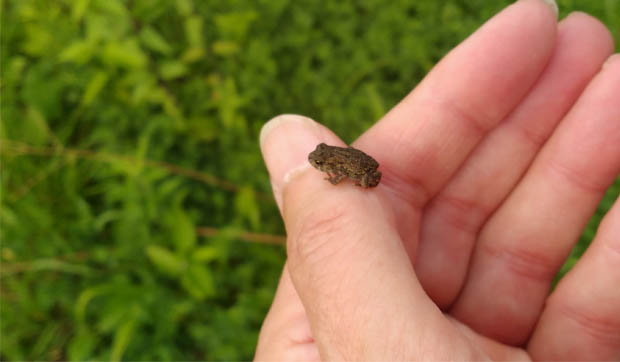A wetter-than-usual spring has benefited local toad populations and now toadlets can be found dispersing throughout our area.
Good Natured: Toads
June 29, 2018
Wow, can you say water, water everywhere?
Our wetter-than-usual spring (and, now, summer) have led to puddles and pools in places that aren’t normally all that wet. Birds love it, as they’re able to bathe frequently and keep their feathers in tip-top shape. Bees love it too, as they, and the flowers they visit, are able to stay healthy and well hydrated.
And toads? They’re having the times of their lives.
American toads, Anaxyrus (formerly Bufo) americanus are fixtures in any area that has some sort of water source in spring-the toad’s breeding season. Like most amphibians, toads require H2O in which to deposit their eggs. But unlike some of our more conservative amphibian species, toads will adopt pretty much any wet spot provided it’s a few inches deep and present for more than a few days.
In the past I’ve found toad eggs (which look like a long string of dark beads encased in a translucent tube) in flooded tire ruts on dirt roads; in wet roadside ditches; and, once, swishing forlornly back and forth on the top step of the entrance to an in-ground pool.
All this is to say that, given the large amount of rain we’ve had, we’re now looking at a large amount of baby toads.
Toadlets, as they’re sometimes known, face enormous odds against their survival. But the ones we’re seeing now actually are the lucky ones.
Toad parents’ relaxed standards for natal pools mean their offspring might not even make it out of the tadpole stage to begin with. Small puddles can dry up, and even if the water does remain the lure of soft, defenseless eggs or tads is irresistible to most predators.
Those that make it to metamorphosis-that amazing stage where the tadpole sprouts limbs and starts bringing in oxygen with its lungs rather than gills-must run, er, hop, a gauntlet of threats that include mammals, birds, reptiles and humans.
That’s right folks. Even when we’re trying to be careful, it’s nearly impossible to avoid stepping on or driving over the little guys if you happen to find yourself in a particularly toad-rich area. Imagine several dozen toadlets, barely larger than pencil erasers, skipping willy-nilly around your feet or embarking, en masse, on a trip across a driveway. Some inevitably will get squished.
You may have noticed, though, that we really have no shortage of toads anywhere the habitat is suitable. And for that we can thank the species’ tremendous reproductive potential.
A female American toad has the capacity to produce anywhere from 2,000 to 10,000 eggs during the breeding season-a period of time that can last a month or more if the warm, rainy conditions they require persist.
Some of you have called to ask why we’re seeing lots of toads, but not other types of frogs, bouncing around the landscape. One reason is those sheer numbers. The number of eggs per female for chorus frogs, another common species in our area, is around 500. And for spring peepers, it’s 200 to 1,200.
Toads also possess the important distinction of being the only local frog likely to be out hopping during the day. For this they have their “warty,” dry skin to thank. Other species with smooth and moist skin typically need to restrict their overland movements to nighttime, when temperatures are lower and humidity is higher.
If you’ve recently found your yard-in the words of one recent caller-overrun with toads, consider yourself lucky! Toads bring a lot to the table. They feed on all sorts of critters that might otherwise be pesty and will work hard to keep populations of slugs, crickets and even mosquitoes in check.
A preponderance of toads also means your neighborhood isn’t overburdened with lawn chemicals. Pesticides and fertilizers easily penetrate amphibian skin, and the outcome isn’t good.
If you want to have some toad fun of your own, dial back on the weed killers and bug sprays, offer plenty of shade and then…just add water!
Pam Erickson Otto is the manager of nature programs and interpretive services at the Hickory Knolls Discovery Center, a facility of the St. Charles Park District. She can be reached at 630-513-4346 or potto@stcparks.org.

